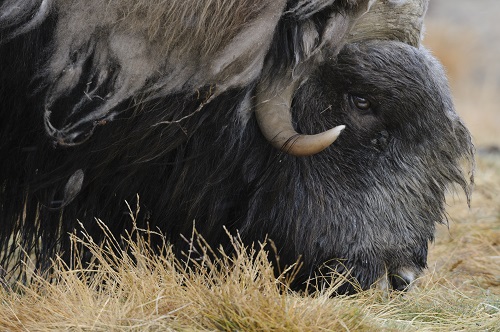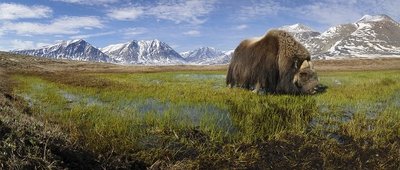Show me your rump hair and I will tell you what you ate
New research reveals the dietary history of muskoxen in Greenland

There is a whole life history accumulated in the hair – or at least the past 2,5 years’ diet, in the case of muskoxen from Northeast Greenland.
ARC PhD student Jesper B Mosbacher has together with his colleagues sampled hair from ten muskoxen cows from high arctic and analysed nitrogen stable isotopes (δ15N) to reconstruct the dietary history of these animals.
The diet was linked to changes in temperature and snow depth. The summer diets were dominated by grasses and were highly similar across years and, whereas the winter diets varied markedly depending on local temperature and snow depth.
In winters with heavy snowfall, the values of δ15N in muskoxen guard hair increased. This indicates that the animals had limited access to forage and relied instead on their body stores to get through the extreme season. This led to low calf production the following year.
Hence, due to the close link between body condition and the production of calves, this new method may help to monitor animal populations in difficult-to-access areas undergoing climate change.
This study sheds light on fundamental questions in animal ecology, namely, the link between environmental conditions and the diet of the animals. Resource availability is linked to population dynamics, and drives changes in population dynamics. This kind of information is also necessary to establish proper conservation and management initiatives. The study is collaboration between ARC, Center for Permafrost at Copenhagen University, Norwegian Institute of Nature Research and Copenhagen Zoo.
This study is part of Jesper B Mosbacher's PhD project, which focuses on one of the key species in the Arctic ecosystem, the muskox, Ovibos moschatus. The feeding ecology of muskoxen is pivotal on many scales, both directly, influencing the success of the individual muskox, and indirectly, affecting the composition and functions of entire communities. The Arctic is changing rapidly, and the understanding of key species in the tundra ecosystem is crucial for our understanding of ecosystem-level responses to climate change. Jesper conducts field work at Zackenberg, Northeast Greenland, in the world’s largest national park (972,000 km2).
Read more about the study on EurekAlert.
Read the article at ScienceNordic.
Read the article: Mosbacher JB, Michelsen A, Stelvig M, Hendrichsen DK & Schmidt NM 2016. Show Me Your Rump Hair and I Will Tell You What You Ate - The Dietary History of Muskoxen (Ovibos moschatus) Revealed by Sequential Stable Isotope Analysis of Guard Hairs. PLoS ONE 11(4): e0152874. doi:10.1371/journal.pone.0152874

Muskoxen forages mainly on energy rich graminoids in productive wet ecosystems during summer. Photo Lars Holst Hansen, Aarhus University.
